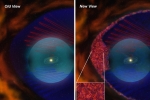Universe Measured With Near-Perfect Accuracy: Scientists Say It's Probably Infinite, Flat, And Eternal

Scientists announced Thursday that they've pretty much figured out the universe, unlocking potential clues to mysterious "dark energy;" bolstering theories that the universe is flat, eternal, and infinite; and mapping 1.3 million galaxies down to about 1 percent accuracy. All of this from an experiment that isn't even done collecting data yet. It's supposed to keep going until June.
"We've done the analysis now because we have 90 percent of [the experiment's] final data, and we're tremendously excited by the results," says Martin White, chair of the survey team and physicist at the University of California, Berkeley. They announced the findings Thursday and have submitted their paper for publication with the journal Monthly Notices of the Royal Astronomical Society. The team has good reason to be excited: no one has ever mapped the universe so accurately. As team leader David Schlegel put it, "I now know the size of the universe better than I know the size of my house."
Like Us on Facebook
They did it using a high-powered telescope at the Apache Point Observatory in New Mexico, which, for almost five years, has been hunting deep space for galaxies. Some of them are more than 6 billion light-years away and, therefore, at least as many years old (FYI, a light-year is a distance, equal to about 5.9 trillion miles). They say it may be the largest collection of redshift galaxies (galaxies moving away from us) ever compiled. By comparison, the new Hubble photo of deep space, said to capture the farthest reaches yet, only shows galaxies 3.5 billion light-years from earth.
With that information, the physicists looked for clusters of galaxies called Baryon acoustic oscillations, or baryons, which arrange themselves in circles around a central cluster. They're basically caused by pressure ripples from when the universe was formed about 13.4 billion years ago, which cooled and froze. In this case, they proved useful because the radius of each cluster is always the same. In effect, they are a 500-million-light-years-long measuring tape.
The scientists translated the data into a 3-D map of the universe. What they discovered is that the universe is "flat" — not in the two-dimensional sense, but in the physicist jargon sense. That is, its shape adheres to principles of basic fourth-grade geometry: A triangle's angles add up to 180 degrees, and that kind of thing. Here's the cool part about that: "One of the reasons we care is that a flat universe has implications for whether the universe is infinite," Schlegel says in the news release. "That means — while we can't say with certainty that it will never come to an end — it's likely the universe extends forever in space and will go on forever in time. Our results are consistent with an infinite universe."
That said, there will always be dissenting voices. These physicists in Denmark say the universe could die at any moment, and that this outcome is more likely that previously thought. "Maybe the collapse has already started somewhere in the universe, and right now it is eating its way into the rest of the universe," they said. "Maybe a collapse is starting right now, right here. Or maybe it will start far away from here in a billion years. We do not know."
© 2012 iScience Times All rights reserved. Do not reproduce without permission.

25 Year Study Reveals Eco-Farming To Be Economically Feasible And Sustainable

How Methane-Producing Microbes Caused The Largest Mass Extinction The World Has Ever Seen

Terrifying Animatronic Robot Dances To 'Blurred Lines,' Causes Nightmares [VIDEO]

Scientists Demonstrate Three-Way Quantum Communication: What's Faster Than The Speed Of Light?

Woolly Mammoth DNA To Be Cloned, Then Joined With Elephant DNA To Create New Creature

Oculus Rift Headset Will Take You On A Trip To Space, All From The Comfort Of Your Couch



![How to Turn Your Tap Water Faucet Into a Coffee Spout [VIDEO]](../../../cdn-sub/data/thumb/mainpage/6005-150100-coffee.jpg)

